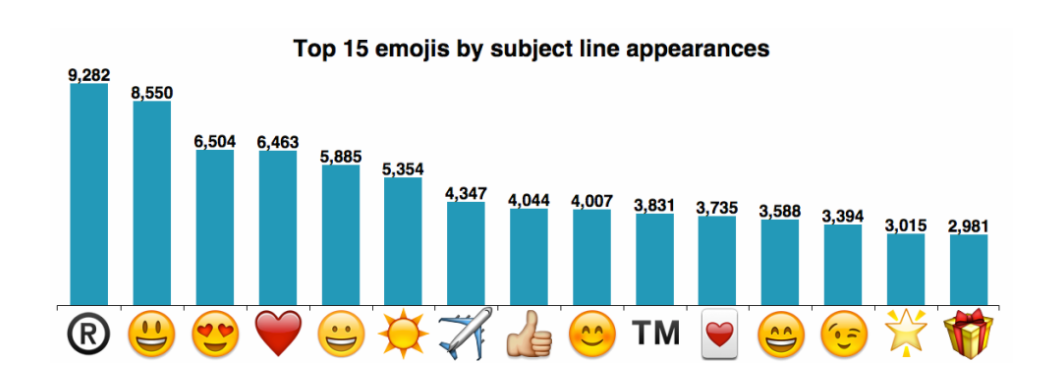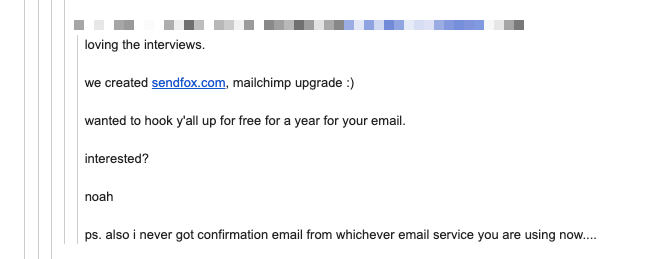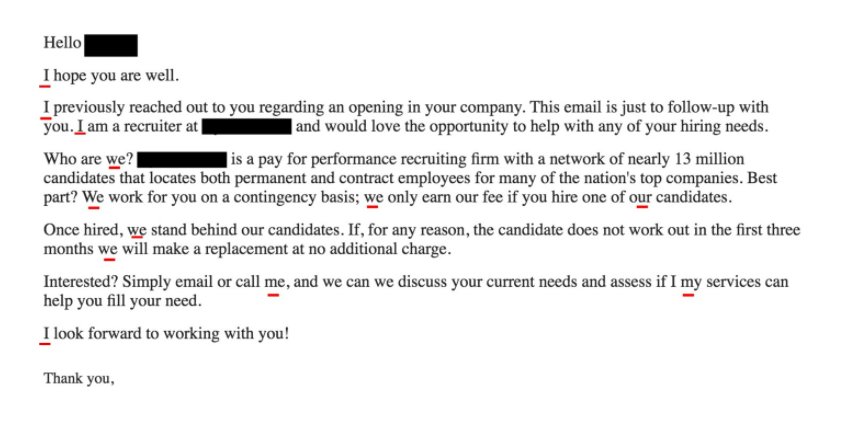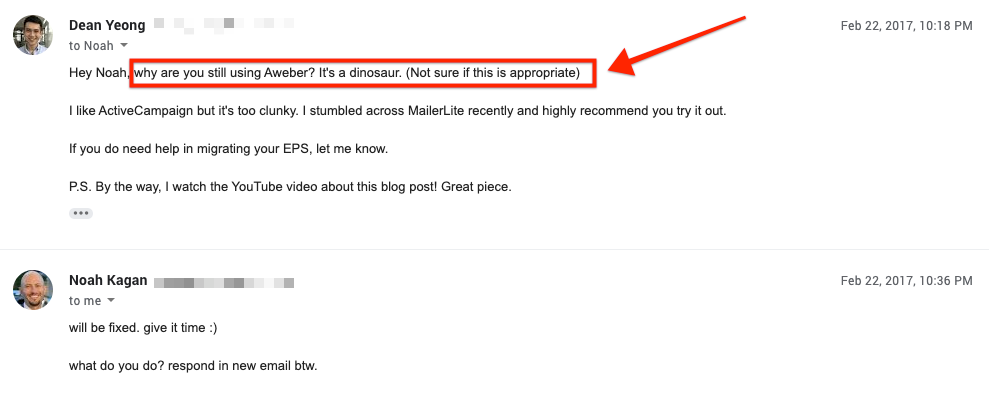Is cold email dead? Far from it.
We have been sending cold emails since Day 1 at AppSumo and Sumo… And we’re still doing it today.
In this post, I’m going to give you five of our best cold email templates. Hundreds of hours of work have gone into these templates, and they’re yours for free.
By the end of the post, I’ll also share with you how our team writes the best cold email in the industry.
Let’s dive straight in.
%(tableofcontents)
Email Template #1: First Contact With a New Prospect
This email template is perfect for making your first contact with a new prospect. The goal is to offer something super valuable to their business for free.
EMAIL BODY:
Hey [First Name],
I saw you on Yelp and was impressed by your 4-star rating for home care.
We help home care businesses increase revenue by 50%.
Love to send you our top 10 ways to do that.
Is this the best mailing address for you?
522 e. 6th Street
2nd Floor
Austin, TX 78701
Sincerely,
[Your Name]
WHY IT WORKS:
The key with this cold email template is to offer a clear, tangible benefit to your prospect without asking for anything in return. You just want to help them.
A couple of key points:
-
Do your research. In this example we used Yelp reviews, but you could use any review site or information you can find about their company online. Show them that you’ve taken the time to craft this email just for them.
-
Make your offer relevant. How can your business help them? Offer something relevant to their business that will help them reach a key goal/milestone. Think revenue, traffic, sales, leads, customers, etc.
Email Template #2: Business Development
The goals of this email are simple:
To showcase how awesome your company is (social proof) and recruit a new partner/customer/make a sale.
EMAIL BODY:
Hey [First Name],
I’ve heard amazing things about [Company Name] lately and I just had to reach out 🙂
AppSumo is hand-selecting a few stellar products to feature in October and we would love to showcase [Company Name] to over 730,000+ potential new customers.
When we asked our customers if they'd be interested in a product like yours, we got a huge resounding "yes!".
I think they would make for great lifetime [Company Name] customers.
Here is some more info on our reach, our customers, and who we've worked with in the past: http://www.appsumo.com/business/
Please email me by the 30th and we'll make it happen.
Cheers,
[Your Name]
WHY IT WORKS:
This email is all about showcasing the value you can deliver to the partner.
-
We can put you in front of 730,000+ potential new customers.
-
Our audience has already told us they’d LOVE your product.
-
We’ve worked with a bunch of awesome companies.
Who would turn down that deal? You have to make replying to your cold email a no-brainer.
A couple of key points:
-
You need to understand what the priorities of the other business are before you try to work with them. What are they trying to achieve, and how can you help them do it?
-
You MUST show proof that you are worth their time to even consider chatting with you.
Email Template #3: Follow Up after No Response
Sometimes we all miss emails or forget to reply. Following up is one of the MOST important things in any cold email strategy.
Use this template to follow up on a previous cold email…
EMAIL BODY:
Hey [First Name],
Hope you had an amazing weekend.
Wanted to see what your team thought of my suggestions… Let me know if I can help at all.
All the best,
[Your Name]
WHY IT WORKS:
This email acts as a quick reminder of your initial cold email. It works because it increases the chance of your prospect seeing your email.
Here is more on how to craft an effective follow-up email.
Email Template #4: Quick Referral
This cold email template is a perfect way to introduce yourself and your company to a potential new prospect.
EMAIL BODY:
Hey [First Name],
[Your Name] from Sumo here. Hope you don’t mind me reaching out 🙂
We help businesses like [Client 1] and [Client 2] to grow their email lists and traffic.
I’m curious who might be best to speak with about email marketing at your company?
Cheers,
[Your Name]
WHY IT WORKS:
I can’t tell you how many times I’ve received pitches that were irrelevant to me and my work at Sumo.
This cold email template will ensure you don’t make this fatal cold email mistake and that you’re contacting the right person at the company you’re reaching out to.
A couple of key points:
-
Make sure the person you’re reaching out to is at least in the right department you want to be speaking to. You don’t want to send an email about marketing to a lead developer, for example.
-
Have your follow-up prepared; once you get a reply to this email, you don’t want to keep your new lead waiting for a reply.
Email Template #5: Make connections
This is an alternative to the dreaded “can I pick your brain?” email. The truth is… no one likes to receive those messages.
If you’re looking to introduce yourself to someone new, why not try being helpful rather than going right in with an ask for their time.
EMAIL BODY:
Hey [First Name],
I saw on Twitter you’ve been sharing some awesome posts on conversion rate optimization.
Recently I spotted these two super helpful posts and just wanted to share them with you:
-
[Link 1]
-
[Link 2]
Would also be happy to share a little about our conversion rates at Sumo if you’re up for it?
Cheers
[Your Name]
WHY IT WORKS:
This one works because you’re trying to deliver value to your prospect before you make an ask.
A couple of key points:
-
Don’t just share your stuff. Your blog might be awesome, but the goal of this email is to build a relationship, not get one click to your content. Share the most useful/valuable content you can find.
-
Do your research. Twitter is a goldmine for this. Head over to your prospect’s Twitter page and look at what they’ve been sharing recently.
Cold Email Tip #1: Write an Open-Worthy Email Subject Line
Getting your email opened is one of the most crucial steps for cold email.
Here are three steps to writing awesome, open-worthy cold email subject lines:
1. USE QUESTIONS
Asking or saying you have a question in your subject line is the easiest way to get your email opened.
Case in point, here’s our highest-opened cold email subject line:

It’s nothing complex. We’re just letting you know we have a quick question. What’s powerful about this subject line is:
-
Quick questions don’t take up a lot of your time, so the time commitment upfront is small.
-
You selfishly want to know what the quick question is.
Here’s an example of the quick question headline from Will on Sumo’s sales team:

You can see the difference when I take subject lines we’ve received (that we didn’t open) and turn them into questions:
-
FW: Checking in → Everything ok?
-
One minute demo → Want to see what I can do in a minute?
-
Sumo – Business Opportunity → Do you think this is a good idea?
-
Your site → Did you know this was on your site?
You’re INSTANTLY more curious about what’s in those emails.
2. “I FOUND YOU THROUGH [CONTACT NAME]”
This cold email subject line has been found to generate an INCREDIBLE open rate of 86.6%.
If you have any mutual connections or have been introduced to this prospect by a mutual connection, this subject line almost guarantees an open.
If you don’t have a mutual connection with your prospect, then substituting the [contact name] for a platform can also work and has been found to generate an open rate of ~64%.
For example:
-
I found you on Twitter
-
I found you on Forbes
-
I found you on LinkedIn
3. EXPERIMENT WITH EMOJIS
Emojis have been found to increase open rates.

It could be a good strategy to experiment with emojis in your subject lines to see how they affect cold email open rates, too.
For example:
-
quick question 🤔
-
Growing Sumo’s traffic 📈
-
Great to meet you 👋
Cold Email Tip #2: Be Informal
Wouldn’t it be nice if you could spend the same amount of time writing a cold sales email as a text?
The funny thing is, most people make the mistake of spending all this time writing a cold sales email because they think it has to be clever and proper, completely professional.
But chew on this quote that our sales team lives and dies by:
“When you say you need to be more formal, what you’re really saying is I need to make this more boring.”
99% of the time you’re writing a cold email, formality can be damned. The 1% comes when you talk to Fortune 100 companies, but even then you can still have a little fun.
Our best emails read like a text from your best friend.

Your lead gets 20-40 terrible cold emails per day. If you want a response, you need to stand out.
That’s why our emails follow rules like:
-
Adding nicknames and changing them in every email (we’ve had responses just because we do this).
-
Using lowercase for everything in the subject lines.
-
Writing paragraphs that are one (maybe two) sentences long.
-
Using less than 50 words per email.
-
Making jokes in our emails.
-
Ditching colorful templates and using plain-text emails like you’d regularly get from your coworkers.
Informal doesn’t mean sloppy — it means familiar and casual.
And when you see the results these informal emails get, you’ll wonder why you ever used words like “mutual synergy” in the first place.
Cold Email Tip #3: Get Personal
One trap many people fall for is writing ONE “really good email” they can copy, paste and send to everyone on their list.
But here’s the truth:
“An email written for 100 people will work for 0 people. It’s not personalized, and people can smell a cookie-cutter email a mile away.”
Personalization at the outset of your email is crucial for two reasons:
-
It shows you took the time to learn about the person/company. The couple minutes it took to do research feels like an “extra mile” gesture to your lead.
-
It shows you’re not a robot. Copy/paste emails suck, and your lead doesn’t feel like it’s meant for them.
Those two aspects work in tandem to keep your lead reading and interested.
After thousands of emails, we’ve tried three main personalized openings and ranked them in order of most effective to least:
1. COMMON INTEREST
Do you know if your lead likes a pro sports team? Make a reference to a recent game their team played in your opening line.
You can dig into social media and generally find something your lead is passionate about (outside of work).
Most people get hit with so many sales messages a day, so a disarming opening about a personal interest really stands out.
Here’s an awesome example of this in action from Will on Sumo’s sales team:

2. KNOWLEDGE OF SITE/PRODUCT
Show you’ve researched your lead by offering an in-depth take on their site or product.
“Hey, I’m a big fan of the blog! I read it all the time,” isn’t an example of personalization.
“Hey, I really loved (specific blog post) because (value you got out of it).” Being specific and sincere separates you from people who send blanket emails.
Here’s an example that clearly shows our sales rep had done their homework before emailing the prospect:

3. RECENT NEWS
Want to show your email isn’t some old thing written months (or years) ago? Add some current events in your first line.
This one is more hit and miss because:
-
It can’t be unrelatable (i.e. citing the newest T-Swift/Katy Perry to a 50-year-old).
-
It can’t be too polarizing (“Wow, can you believe what our president just did? Crazy.”).
If you can find the right ice-breaker, this can work.
Once you start off on the right foot and get your lead’s attention, you go into the meat of the email…
Cold Email Tip #4: What’s In It for Them?
You know who the “Me Monsters” are.
You try to have a normal conversation with them. But every time you bring something up, they jiu-jitsu their way into talking about themselves.
It’s so damn annoying.
Yet you read emails like this all the time:

I, I, I. We, we, we This email is all about their company and not about the reader.
If you’re talking that much about you, then how can your lead really feel out what’s in it for them?
After you nail the intro, you enter what’s called the “what’s in it for them” stage. This should be about three things:
-
What’s currently wrong.
-
How you can help.
-
What the value of that help brings.
Let’s start with what’s going wrong. You might reflexively shy away from this because it seems like a negative thing to say so soon.
Don’t. If things are going right, there’s almost no incentive to change.
You have to bring up where someone is falling behind in order to get their attention.
If you’re writing a cold email, do some research on their site or business on where they can improve (specifically with your product).
Generally, you’ll find one of three things to bring up:
-
They’re missing out on sales because their competition is doing something they aren’t doing.
-
They’re missing out on sales because something isn’t optimized or is broken.
-
The current tools they use are slow, hard to use or too expensive.
Here’s an example Dean first outreach to the Chief Sumo. Sorry, Aweber.

When you pinpoint which problem is most prevalent, you can point it out tactfully (but plainly):
-
“I noticed you’re using X, which I know takes over Y hours to set up each time you use it.”
-
“I took a look at your site and saw your opt-in box was broken on a few pages, so you’re missing out on a ton of emails.”
-
“I was inside your store recently and didn’t see you using X that (Competitor) and (Competitor) are using to get Y result.”
Once you point out the bad, you get to be the hero and fix it.
The most important note here: DO NOT SELL YOUR PRODUCT.
Instead, focus on how to help instead of sell. Right now, your lead doesn’t care about your product. They just want to fix the problem you brought up.
If we take the examples we just used, you could say:
-
“I noticed you’re using X, which I know takes over Y hours to set up each time you use it. I can show how to get the same results in 1/8th the time.”
-
“I took a look at your site and saw your opt-in box was broken on a few pages, so you’re missing out on a ton of emails. I know exactly how to fix your opt-in boxes.”
-
“I was inside your store recently and didn’t see you using X that (Competitor) and (Competitor) are using to get Y result. Even though they’re using X, I know a way around it.”
In all these scenarios, you have a seemingly excellent solution and you didn’t even mention your product. You brought up a problem, but you instantly calm the lead down with a solution.
And that’s the bulk of the ask in the first cold email. I didn’t mention the company, or the product, or what my role is. I just said I had a solution to their problem.
It’s short, to the point and provides a lot of value to the lead.
There’s only one thing left (and it’s a big one).
Cold Email Tip #5: Focus on the One Thing
I’ll keep this short.
You got your lead to read this far. Don’t mess it up by being vague or giving them a bunch of options. Instead, focus on ONE call to action.
Give your reader one thing to do, and make it really clear.
-
If you want them to book a time to talk with you, give them a link to your calendar and tell them to click that link.
-
If you want them to email you back, ask them to reply to the email (and don’t give the option of calling or Skype).
-
If you want a reply at all, don’t end your email with something vague like “Let me know!”
This is where the difference between warm and cold emails rears its head once more. Here’s why they’re different:
Warm Emails: You can ask for things like booking a call or setting up a demo. They’re already interested in your product. You don’t need to nurture them as much.
Cold Emails: Your chances of closing are much higher if you ask for a reply in the first email. Action in the first cold email is ridiculously hard. All you’re shooting for is a response.
It’s like chess. One bad move at the very beginning may not be noticeable, but you really feel the consequences later in the game.
If you ask for anything more than a reply in your first cold email, you’re setting yourself up to fail right away.
WANT ALL THE TIPS FROM THIS GUIDE AND 9 PRE-WRITTEN COLD EMAIL TEMPLATES?
Now you have everything to send an effective cold email. But there are more:
-
80 best email subject line formulas to power up your cold email open rates.
-
Everything you need to know about follow-up emails to get a reply.
Before you go, let us know your BIGGEST takeaway in the comment section below.
Add A Comment
VIEW THE COMMENTS